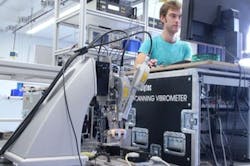University of Stuttgart opens center for Laser-Doppler vibrometry to be used in biomechanics
Stuttgart, Germany--A new "center of excellence" for Laser-Doppler vibrometry was opened on 20 Nov. 2013 at the University of Stuttgart; the aim is to take laser-Doppler vibrometry, a measurement technique often used in mechanical engineering, and to apply it to biomechanics (for example, sound transmission in the ear).
The center is supported by the Institute for Technical and Numeric Mechanics (ITM) at the University of Stuttgart, as well as Polytec (Waldbronn, Germany), a commercial outfit specializing in noncontact vibration-measurement technology.
Laser-Doppler vibrometry determines the velocity (and motions via integration of velocity) of a substance or object via the Doppler effect, in which light reflected from a moving object is shifted in frequency. The technique can be used, for example, to measure blood-pulse velocity, for noncontact heart monitoring, and to measure the motions of microstructures. It can measure movements in the nanometer range and can do this remotely, without disturbing the specimen.
"Laser vibrometry is a basic methodological approach to record and to understand vibrations. It can therefore also be used with biomechanical processes, such as sound transmission through the middle ear to the inner ear," says Albrecht Eiber, the deputy head of ITM. His research includes computer simulation on implants that enables hearing damaged through age, illness, or an accident to be reconstructed. Along with passive prostheses that function as "spare parts," active prostheses can be developed that strengthen the incoming acoustic signal within the ear.
ITM is also collaborating with clinics at the universities of Zurich, Cologne, and Hanover, as well as with several business partners.
Source: http://www.alphagalileo.org/ViewItem.aspx?ItemId=136609&CultureCode=en

John Wallace | Senior Technical Editor (1998-2022)
John Wallace was with Laser Focus World for nearly 25 years, retiring in late June 2022. He obtained a bachelor's degree in mechanical engineering and physics at Rutgers University and a master's in optical engineering at the University of Rochester. Before becoming an editor, John worked as an engineer at RCA, Exxon, Eastman Kodak, and GCA Corporation.
